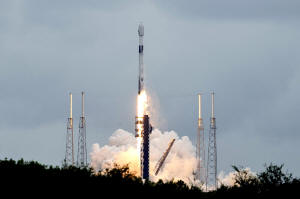A spacecraft is on its way to a harmless asteroid slammed by NASA in a
previous save-the-Earth test
 Send a link to a friend
Send a link to a friend
 [October 08, 2024]
By MARCIA DUNN [October 08, 2024]
By MARCIA DUNN
CAPE CANAVERAL, Fla. (AP) — A spacecraft blasted off Monday to
investigate the scene of a cosmic crash.
The European Space Agency's Hera spacecraft rocketed away on a two-year
journey to the small, harmless asteroid rammed by NASA two years ago in
a dress rehearsal for the day a killer space rock threatens Earth. It's
the second part of a planetary defense test that could one day help save
the planet.
SpaceX’s Falcon rocket quickly disappeared with Hera into the late
morning clouds. An hour later, applause erupted in the control center in
Germany as the spacecraft separated from the rocket’s upper stage and
then called home. “It’s an amazing day,” the space agency’s director
general Josef Aschbacher said afterward.
The 2022 crash by NASA's Dart spacecraft shortened Dimorphos' orbit
around its bigger companion, demonstrating that if a dangerous rock was
headed our way, there’s a chance it could be knocked off course with
enough advance notice.
Scientists are eager to examine the impact’s aftermath up close to know
exactly how effective Dart was and what changes might be needed to
safeguard Earth in the future.

"The more detail we can glean the better as it may be important for
planning a future deflection mission should one be needed,” University
of Maryland astronomer Derek Richardson said before launch.
Researchers want to know whether Dart — short for Double Asteroid
Redirection Test — left a crater or perhaps reshaped the 500-foot
(150-meter) asteroid more dramatically. It looked something like a
flying saucer before Dart’s blow and may now resemble a kidney bean,
said Richardson, who took part in the Dart mission and is helping with
Hera.

Dart’s wallop sent rubble and even boulders flying off Dimorphos,
providing an extra kick to the impact’s momentum. The debris trail
extended thousands of miles (more than 10,000 kilometers) into space for
months.
Some boulders and other debris could still be hanging around the
asteroid, posing a potential threat to Hera, said flight director
Ignacio Tanco.
“We don't really know very well the environment in which we are going to
operate,” said Tanco. "But that's the whole point of the mission is to
go there and find out.”
European officials describe the $400 million (363 million euro) mission
as a “crash scene investigation.”
Hera "is going back to the crime site and getting all the scientific and
technical information,” said project manager Ian Carnelli.
[to top of second column]
|

A SpaceX Falcon 9 rocket lifts off from the Cape Canaveral Space
Force Station, Monday, Oct. 7, 2024 at Cape Canaveral, Fla.,
carrying a European spacecraft to an asteroid. (AP Photo/John Raoux)

Carrying a dozen science instruments, the small car-sized Hera will
need to swing past Mars in 2025 for a gravity boost, before arriving
at Dimorphos by the end of 2026. It's a moonlet of Didymos, Greek
for twin, a fast-spinning asteroid that's five times bigger. At that
time, the asteroids will be 120 million miles (195 million
kilometers) from Earth.
Hera will attempt to go into orbit around the rocky pair, with the
flyby distances gradually dropping from 18 miles (30 kilometers) all
the way down to a half-mile (1 kilometer). The spacecraft will
survey the moonlet for at least six months to ascertain its mass,
shape and composition, as well as its orbit around Didymos.
Before the impact, Dimorphos circled its larger companion from
three-quarters of a mile (1,189 meters) out. Scientists believe the
orbit is now tighter and oval-shaped, and that the moonlet may even
be tumbling.
Two shoebox-sized Cubesats will pop off Hera for even closer
drone-like inspections, with one of them using radar to peer beneath
the moonlet’s boulder-strewn surface. Scientists suspect Dimorphos
was formed from material shed from Didymos. The radar observations
should help confirm whether Didymos is indeed the little moon’s
parent.
The Cubesats will attempt to land on the moonlet once their survey
is complete. If the moonlet is tumbling, that will complicate the
endeavor. Hera may also end its mission with a precarious touchdown,
but on the larger Didymos.
Neither asteroid poses any threat to Earth — before or after Dart
showed up. That’s why NASA picked the pair for humanity’s first
asteroid-deflecting demo.
Leftovers from the solar system’s formation 4.6 billion years ago,
asteroids primarily orbit the sun between Mars and Jupiter in what’s
known as the main asteroid belt, where millions of them reside. They
become near-Earth objects when they’re knocked out of the belt and
into our neck of the woods.
NASA’s near-Earth object count currently tops 36,000, almost all
asteroids but also some comets. More than 2,400 of them are
considered potentially hazardous to Earth.
___
The Associated Press Health and Science Department receives support
from the Howard Hughes Medical Institute’s Science and Educational
Media Group. The AP is solely responsible for all content.
All contents © copyright 2024 Associated Press. All rights reserved
 |